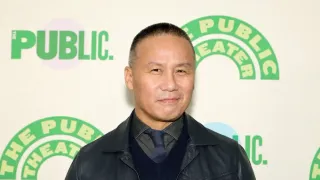April 12, 2019
Johnny Depp's Ex-Wife Heard Asks Judge to Dismiss His Lawsuit
READ TIME: 2 MIN.
Actress Amber Heard asked a judge Thursday to dismiss a $50 million defamation lawsuit her ex-husband Johnny Depp filed over an op-ed about domestic violence she wrote in The Washington Post, and provided new evidence toward her allegations of abuse.
In the motion filed in the Circuit Court of Fairfax, Virginia, Heard describes in new detail more than a dozen instances before and during their marriage when she says Depp slapped her, shoved her, pulled her hair or choked her. Depp has denied any such abuse. The allegations have appeared in the couple's divorce and other legal fights.
Heard includes exhibits such as photos of her with bruises on her face and scars on her arms, images of damage she says Depp did to their home, and newly revealed screenshots of text messages describing the incidents at the time, and excerpts of her divorce deposition describing domestic abuse.
"Johnny Depp physically and verbally abused Amber Heard," her attorney Eric George said in a statement. "Since their divorce, Mr. Depp has continued to publically harass Ms. Heard, and attempted to gaslight the world by denying his abuse. It is long past time for Mr. Depp's despicable conduct to end."
Depp's lawyer said Friday, as the original lawsuit did, that Heard's allegations are false and it was in fact she who was abusive to him."
"The only way for Amber Heard to sustain her hoax is with more lies," Depp attorney Adam Waldman said in an email.
Waldman said he and Depp have collected dozens of videos, photographs and eyewitness to back up assertions she was abusive toward Depp and others, including punching him and throwing a can of paint thinner at his head.
The Post piece by Heard, published in December, does not mention Depp by name or describe any incidents, but it discusses the societal plight of those who speak up about domestic abuse.
"I spoke up against sexual violence – and faced our culture's wrath," the 32-year-old actress wrote, adding that she felt as though she was "on trial in the court of public opinion."
But Depp's lawsuit says it was clear Heard was talking about him, and that it worsened the damage the allegations had already done to his career.
The lawsuit states Depp, 55, has suffered financial losses because of the accusations, including being dropped from his role as Capt. Jack Sparrow in the "Pirates of the Caribbean" films.
Heard's lawyers also argued that the lawsuit should be moved to Los Angeles because that's where the relevant events took place and the court would be in a position to subpoena witnesses and find facts.
Heard first accused Depp of domestic violence in May 2016, the year after they were married. They were divorced in 2017.
The actress, whose credits include "Aquaman" and "Justice League," met Depp on the set of their 2011 film "The Rum Diary."






